- MOE
- National Parks of Japan
- Joshin’etsukogen National Park
- Characteristics
main body

Characteristics
A Recreation Department Store Showcasing Mountains and Highlands
Date of Designation: September 7, 1949
Area: 148,194 ha
Related Prefectures: Gunma, Niigata, Nagano
Area: 148,194 ha
Related Prefectures: Gunma, Niigata, Nagano
The Joshin'etsukogen National Park is an enormous park comprising highlands and mountains, including Mt. Tanigawa (1,977 m above sea level), Mt. Naeba (2,145 m above sea level), Mt. Kusatsu-Shirane (2,160 m above sea level), Mt. Azumaya (2,354 m above sea level), and Mt. Asama (2,568 m above sea level).
The park includes many famous peaks that are numbered amongst the Nihon Hyakumeizan (Hundred famous mountains in Japan) --such as Mt. Tanigawa, with its towering rock slopes, and Mt. Asama and Mt. Kusatsu-Shirane, which are volcanoes --thus forming a richly varying mountain landscape. From the sides to the foot of the mountains spread cool highlands, and there are also numerous lakes and marshes. Another huge attraction of the park is the many hot springs that have been created through volcanic activity.
The park includes many famous peaks that are numbered amongst the Nihon Hyakumeizan (Hundred famous mountains in Japan) --such as Mt. Tanigawa, with its towering rock slopes, and Mt. Asama and Mt. Kusatsu-Shirane, which are volcanoes --thus forming a richly varying mountain landscape. From the sides to the foot of the mountains spread cool highlands, and there are also numerous lakes and marshes. Another huge attraction of the park is the many hot springs that have been created through volcanic activity.
Terrain/ Scenery

Ichinokurasawa Gorge, Mt. Tanigawa
The park comprises high mountains with altitudes around 2,000 m, the highest of which is Mt. Asama, and the bases of these mountains, which form highlands. Excluding the area around Mt. Tanigawa -- the slopes of which are covered in large rocks, like in the Alps --most of the mountains in the park are volcanic landforms. Some of these --like Mt. Kusatsu-Shirane and Mt. Asama -- have frequent eruptive activity, while others --like Mt. Naeba and Mt. Shigayama --are now extinct.
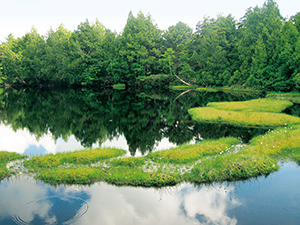
Shibuike Pond (depression in lava rock)
The volcanoes also vary in appearance. Mt. Naeba forms a lava highland with high moor at the peak. The Shiga Highland (Shiga Kogen) was formed by lava flows, and Shibuike Pond and other lakes located within the special protection area comprise water filling depressions in the lava rock.
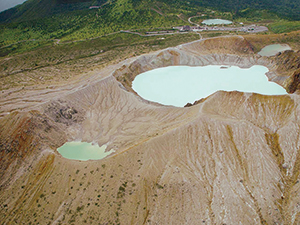
Mt. Kusatsu-Shirane (Yugama Crater Lake and Surrounding Volcanic Desert)
Mt. Kusatsu-Shirane has a distinctive landscape in which the blue-green Yugama Crater Lake and surrounding volcanic desert contrasts with the surrounds volcanic desert. Mt. Azumaya is a stratovolcano, and Sugadaira, which spreads out on the eastside of the base of the mountain, is a highland formed by lava flow from Mt. Azumaya.
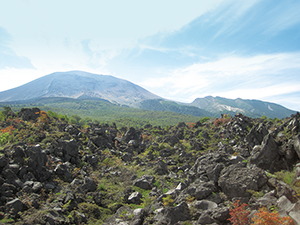
Onioshidashi, Mt. Asama
Mt. Asama is one of Japan's representative volcanoes and continues to erupt regularly. The base of the mountain to the north is a place of scenic beauty formed by lava rocks being pushed upwards, and there is a vast field of lava rock known as Onioshidashi ("Push out the Devils"). In this way, a richly varying landscape has been created by a wide range of volcanic landforms.
Plants
The mountains in the park are covered in forests of Japanese beech and other broadleaf deciduous trees up to an altitude of around 1,500 m; at higher altitudes, subalpine coniferous forests of Japanese hemlock and Maries' fir can generally be seen.
In addition, many mountains in the park have unique plant life due to differences in topography, the periods in which landforms were created through volcanic activity, and the heavy snowfall during winter.
Low trees and shrubs such as mountain ash, heathberry, and bog whortleberry can be seen on still-active volcanoes such as Mt. Kusatsu-Shirane, where forests do not grow.
On Mt. Kusatsu-Shirane and the Shiga Highland (Shiga Kogen), Siberian dwarf pine grows even at altitudes of 2,000 m or less, and alpine floras can be seen on the scree slopes characteristic of volcanoes.
In addition, many mountains in the park have unique plant life due to differences in topography, the periods in which landforms were created through volcanic activity, and the heavy snowfall during winter.
Low trees and shrubs such as mountain ash, heathberry, and bog whortleberry can be seen on still-active volcanoes such as Mt. Kusatsu-Shirane, where forests do not grow.
On Mt. Kusatsu-Shirane and the Shiga Highland (Shiga Kogen), Siberian dwarf pine grows even at altitudes of 2,000 m or less, and alpine floras can be seen on the scree slopes characteristic of volcanoes.
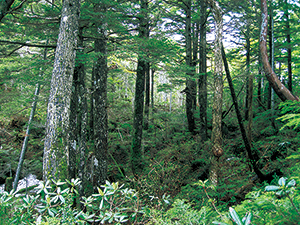
Subalpine coniferous forest (Mt. Shigayama)
Many of the high moors and lakes on Mt. Naeba and the Shiga Highland (Shiga Kogen) developed in the uneven surfaces of lava rock and other volcanic ejecta, and the park has a diverse range of flora, including Scirpus hotarui communities.
In this park, it is possible to see various plants that are peculiar to mountains and highlands. In particular, the alpine floras growing in subalpine belt, flowers blooming in wetland areas, and Japanese azalea growing on the Yunomaru Highland in particular are all very well-known, and many people visit the park to see them.
In this park, it is possible to see various plants that are peculiar to mountains and highlands. In particular, the alpine floras growing in subalpine belt, flowers blooming in wetland areas, and Japanese azalea growing on the Yunomaru Highland in particular are all very well-known, and many people visit the park to see them.
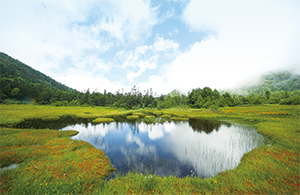
High Moor (Shijuhachiike Marshland)
Wildlife
Mammals living in the park area include black bears, Japanese serow, Japanese monkeys, Japanese squirrels, Japanese stoats and dormice.
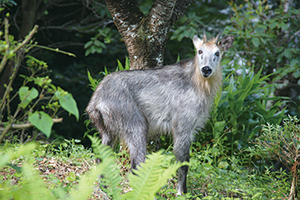
Japanese Serow
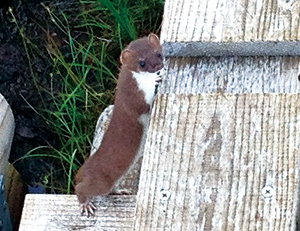
Japanese Stoat
Bird species living in the park area include golden eagles, mountain hawk-eagles, and other birds of prey, as well as spotted nutcrackers and house martins.
Insect species living in the park include various rare alpine butterflies such as Erebia niphonica.
Insect species living in the park include various rare alpine butterflies such as Erebia niphonica.
Culture
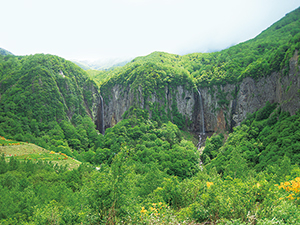
Yonako Falls (Left: Gongen Waterfall; Right: Fudo Waterfall)
With its concentration of volcanoes, the park has an abundance of hot springs and is dotted with ancient hot spring districts --such as Shima Onsen, Kusatsu Onsen, Manza Onsesn, Kazawa Onsen, and Yamada Onsen --that have been frequented by numerous famous writers and artists over their long histories.
The park has also been a place for mountain worship since ancient times, with pilgrims making spiritual climbs of and worshipping on Mt. Naeba, Mt. Tanigawa, and other mountains. Alongside the Yonago-Takizan Fudo-ji Okuno-in Temple, the sacred Yonako Falls have been a place for mountain spiritual training since time immemorial, and in summer Shugenja (mountaineering ascetics) can be seen performing ablutions in the water. Also, since the early days of modern mountain-climbing, the mountains in the area have been used for hiking and skiing, and Kazawa Onsen is the birthplace of the song Yukiyama Sanka (“Snowy Mountains Anthem”), which is set to the music of Oh My Darling, Clementine.
The park has also been a place for mountain worship since ancient times, with pilgrims making spiritual climbs of and worshipping on Mt. Naeba, Mt. Tanigawa, and other mountains. Alongside the Yonago-Takizan Fudo-ji Okuno-in Temple, the sacred Yonako Falls have been a place for mountain spiritual training since time immemorial, and in summer Shugenja (mountaineering ascetics) can be seen performing ablutions in the water. Also, since the early days of modern mountain-climbing, the mountains in the area have been used for hiking and skiing, and Kazawa Onsen is the birthplace of the song Yukiyama Sanka (“Snowy Mountains Anthem”), which is set to the music of Oh My Darling, Clementine.

Highland Vegetable Field
The vast vegetable fields around the foot of Mt. Asama can be said to present a landscape where the climate and weather in the volcanic highland harmonizes with human activity.
